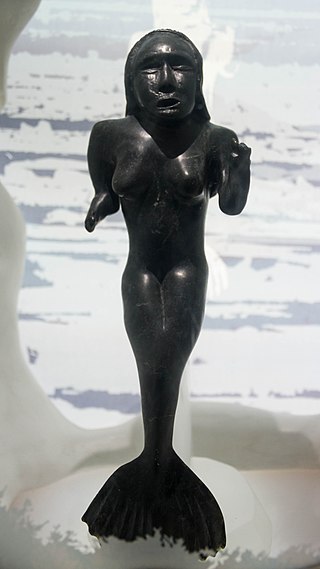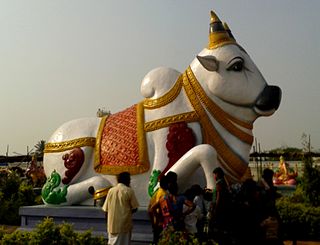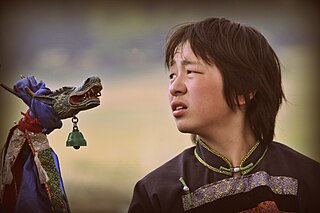Related Research Articles
Animism is the belief that objects, places, and creatures all possess a distinct spiritual essence. Animism perceives all things—animals, plants, rocks, rivers, weather systems, human handiwork, and in some cases words—as being animated, having agency and free will. Animism is used in anthropology of religion as a term for the belief system of many Indigenous peoples in contrast to the relatively more recent development of organized religions. Animism is a metaphysical belief which focuses on the supernatural universe : specifically, on the concept of the immaterial soul.

Shamanism or samanism is a religious practice that involves a practitioner interacting with the spirit world through altered states of consciousness, such as trance. The goal of this is usually to direct spirits or spiritual energies into the physical world for the purpose of healing, divination, or to aid human beings in some other way.

Spirit possession is an unusual or an altered state of consciousness and associated behaviors which are purportedly caused by the control of a human body and its functions by spirits, ghosts, demons, angels, or gods. The concept of spirit possession exists in many cultures and religions, including Buddhism, Christianity, Haitian Vodou, Dominican 21 Divisions, Hinduism, Islam, Wicca, and Southeast Asian, African, and Native American traditions. Depending on the cultural context in which it is found, possession may be considered voluntary or involuntary and may be considered to have beneficial or detrimental effects on the host. Spirit possession is often regarded as a reason in support of spirits, deities or demons. In a 1969 study funded by the National Institute of Mental Health, spirit possession beliefs were found to exist in 74% of a sample of 488 societies in all parts of the world, with the highest numbers of believing societies in Pacific cultures and the lowest incidence among Native Americans of both North and South America. As Pentecostal and Charismatic Christian churches move into both African and Oceanic areas, a merger of belief can take place, with demons becoming representative of the "old" indigenous religions, which the Christian ministers attempt to exorcise.

Inuit religion is the shared spiritual beliefs and practices of the Inuit, an indigenous people from Alaska, northern Canada, parts of Siberia and Greenland. Their religion shares many similarities with some Alaska Native religions. Traditional Inuit religious practices include animism and shamanism, in which spiritual healers mediate with spirits. Today many Inuit follow Christianity, but traditional Inuit spirituality continues as part of a living, oral tradition and part of contemporary Inuit society. Inuit who balance indigenous and Christian theology practice religious syncretism.

Anthropology of religion is the study of religion in relation to other social institutions, and the comparison of religious beliefs and practices across cultures. The anthropology of religion, as a field, overlaps with but is distinct from the field of Religious Studies. The history of anthropology of religion is a history of striving to understand how other people view and navigate the world. This history involves deciding what religion is, what it does, and how it functions. Today, one of the main concerns of anthropologists of religion is defining religion, which is a theoretical undertaking in and of itself. Scholars such as Edward Tylor, Emile Durkheim, E.E. Evans Pritchard, Mary Douglas, Victor Turner, Clifford Geertz, and Talal Asad have all grappled with defining and characterizing religion anthropologically.

In European folklore of the medieval and early modern periods, familiars were believed to be supernatural entities or spiritual guardians that would protect or assist witches and cunning folk in their practice of magic. According to records of the time, those alleging to have had contact with familiar spirits reported that they could manifest as numerous forms, usually as an animal, but sometimes as a human or humanoid figure, and were described as "clearly defined, three-dimensional... forms, vivid with colour and animated with movement and sound", as opposed to descriptions of ghosts with their "smoky, undefined form[s]".

Maria Antonina Czaplicka, also referred to as Marya Antonina Czaplicka and Marie Antoinette Czaplicka, was a Polish cultural anthropologist who is best known for her ethnography of Siberian shamanism. Czaplicka's research survives in three major works: her studies in Aboriginal Siberia (1914); a travelogue published as My Siberian Year (1916); and a set of lectures published as The Turks of Central Asia (1918). Curzon Press republished all three volumes, plus a fourth volume of articles and letters, in 1999.

Animal worship is an umbrella term designating religious or ritual practices involving animals. This includes the worship of animal deities or animal sacrifice. An animal 'cult' is formed when a species is taken to represent a religious figure. Animal cults can be classified according to their formal features or by their symbolic content.
Kıdaai Maqsin or Kudaai Bakhsilaan is a fire-demon in Yakut mythology. He was the first blacksmith and the originator of ironworking. He lives in an iron house surrounded by flames.
Neoshamanism refers to new forms of shamanism. It usually means shamanism practiced by Western people as a type of New Age spirituality, without a connection to traditional shamanic societies. It is sometimes also used for modern shamanic rituals and practices which, although they have some connection to the traditional societies in which they originated, have been adapted somehow to modern circumstances. This can include "shamanic" rituals performed as an exhibition, either on stage or for shamanic tourism, as well as modern derivations of traditional systems that incorporate new technology and worldviews.

Felicitas D. Goodman was an American linguist and anthropologist. She was a highly regarded expert in linguistics and anthropology and researched and explored Ecstatic Trance Postures for many years. She studied the phenomenon of "speaking in tongues" in Pentecostal congregations in Mexico. She is the author of such well-received books as Speaking in Tongues and Where the Spirits Ride the Wind: Trance Journeys and Other Ecstatic Experiences. Her work has been published mostly in the United States and Germany.

Tengrism is a religion originating in the Eurasian steppes, based on shamanism and animism. It generally involves the titular sky god Tengri, who is not considered a deity in the usual sense but a personification of the universe. According to some scholars, adherents of Tengrism view the purpose of life to be in harmony with the universe.

A large minority of people in North Asia, particularly in Siberia, follow the religio-cultural practices of shamanism. Some researchers regard Siberia as the heartland of shamanism.

Shamanic Music is ritualistic music used in religious and spiritual ceremonies associated with the practice of shamanism. Shamanic music makes use of various means of producing music, with an emphasis on voice and rhythm. It can vary based on cultural, geographic, and religious influences.

Michael James Harner was an anthropologist, educator and author. His 1980 book, The Way of the Shaman: a Guide to Power and Healing, has been foundational in the development and popularization of core shamanism as a New Age path of personal development for adherents of neoshamanism. He also founded the Foundation for Shamanic Studies.
The spirit spouse is a widespread element of shamanism, distributed through all continents and at all cultural levels. Often, these spirit husbands/wives are seen as the primary helping spirits of the shaman, who assist them in their work, and help them gain power in the world of spirit. The relationships shamans have with their spirit spouses may be expressed in romantic, sexual, or purely symbolic ways, and may include gender transformation as a part of correctly pairing with their "spouse". Shamans report engaging with their spirit spouses through dreams, trance, and other ritual elements. In some cultures, gaining a spirit spouse is a necessary and expected part of initiation into becoming a shaman. Examples of spirit spouses may be seen in non-shamanic cultures as well, including dreams about Jesus Christ by nuns, who are considered to be "brides of Christ".

Mongolian shamanism, more broadly called the Mongolian folk religion, or occasionally Tengerism, refers to the animistic and shamanic ethnic religion that has been practiced in Mongolia and its surrounding areas at least since the age of recorded history. In the earliest known stages it was intricately tied to all other aspects of social life and to the tribal organization of Mongolian society. Along the way, it has become influenced by and mingled with Buddhism. During the socialist years of the twentieth century, it was heavily repressed, but has since made a comeback.
Black shamanism is a kind of shamanism practiced in Mongolia and Siberia. It is specifically opposed to yellow shamanism, which incorporates rituals and traditions from Buddhism. Black Shamans are usually perceived as working with evil spirits, while white Shamans with spirits of the upper world.

Sergei Aleksandrovich Tokarev was a Russian scholar, ethnographer, historian, researcher of religious beliefs, doctor of historical sciences, and professor at Moscow State University.
Shamanism is a religious practice present in various cultures and religions around the world. Shamanism takes on many different forms, which vary greatly by region and culture and are shaped by the distinct histories of its practitioners.
References
- Stutley, Margaret (2003). Shamanism: An Introduction. Psychology Press. ISBN 978-0-415-27318-3.
- Czaplicka, Marie Antoinette (1914). Aboriginal Siberia : a study in social anthropology. Robarts - University of Toronto. Oxford : Clarendon Press.